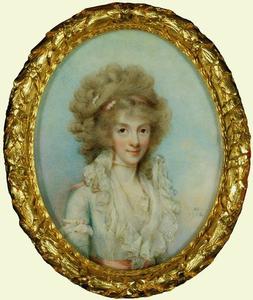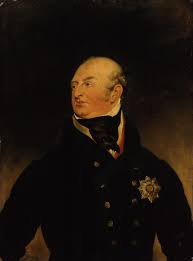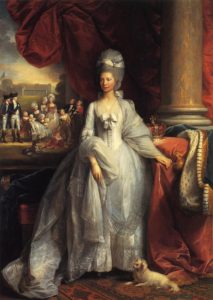
In this installment in the series, we turn to contemporary sources for a look at the social circle of Frederica, Duchess of York, and thereby for more glimpses into the personality of the woman herself. What better place to start than with Charles Greville’s Diaries:
August 15th, 1818 — “The parties at Oatlands take place every Saturday, and the guests go away on Monday morning. These parties begin as soon as the Duchess leaves London, and last till the October meetings. During the Egham races there is a large party which remains there from the Saturday before the races till the Monday se’nnight following; this is called the Duchess’s party, and she invites the guests. The Duke is only there himself from Saturday to Monday. There are almost always the same people, sometimes more, sometimes less. We dine at eight, and sit at table till eleven. In about a quarter of an hour after we leave the dining-room the Duke sits down to play at whist, and never stirs from the table as long as anybody will play with him. When anybody gives any hint of being tired he will leave off, but if he sees no signs of weariness in others he will never stop himself. He is equally well amused whether the play is high or low, but the stake he prefers is fives and ponies (Five-pound points and twenty-five pounds on the rubber). The Duchess generally plays also at half-crown whist. The Duke always gets up very early, whatever time he may go to bed. On Sunday morning he goes to church, returns to a breakfast of tea and cold meat, and afterwards rides or walks till the evening. On Monday morning he always sets off to London at nine o’clock. He sleeps equally well in a bed or in a carriage.

“. . . . (The Duchess’s) dogs are her greatest interest and amusement, and she has at least forty of various kinds. She is delighted when anybody gives her a dog, or a monkey, or a parrot, of all of which she has a vast number; it is impossible to offend her or annoy her more than by ill-using any of her dogs, and if she were to see anybody beat or kick any one of them she would never forgive it. She has always lived on good terms with the Royal Family, but is intimate with none of them, and goes as little as possible to Court. The Regent dislikes her, and she him. With the Princess Charlotte she was latterly very intimate, spent a great deal of time at Claremont, and felt her death very severely. The Duchess has no taste for splendour or magnificence, and likes to live the life of a private individual as much as possible.
“. . . . . The Duke and the Duchess live upon the best terms; their manner to one another is cordial, and while full of mutual respect and attention, they follow separately their own occupations and amusements without interfering with one another. Their friends are common to both, and those who are most attached to the Duke are equally so to the Duchess. One of her few foibles is an extreme tenaciousness of her authority at Oatlands; one way in which this is shown is in the stable, where, although there are always eight or ten carriage-horses which seldom do any work, it is impossible ever to procure a horse to ride or drive, because the Duchess appropriates them all to herself. The other day one of the aides-de-camp (Cooke) wanted to drive Burrell (who was there) to Hampton Court; he spoke of this at breakfast, and the Duke hearing it, desired he would take the curricle and two Spanish horses which had been given to him. The Duchess, however, chose to call these horses hers and to consider them as her own. The curricle came to the door, and just as they were going to mount it a servant came from the Duchess (who had heard of it) and told the coachman that her Royal Highness knew nothing of it, had not ordered it, and that the curricle must go home, which it accordingly did.”
September 3rd.— “I went to Oatlands for the Egham races. The party lasted more than a week; there was a great number of people, and it was very agreeable. . . . We played at whist every night that the Duke was there, and I always won. The Duchess was unwell most of the time. We showed her a galanterie which pleased her very much. She produced a picture of herself one evening, which she said she was going to send to the Duchess of Orleans; we all cried out, said it was bad, and asked her why she did not let Lawrence paint her picture, and send a miniature copied from that. She declared she could not afford it; we then said, if she would sit, we would pay for the picture, which she consented to do, when all the men present signed a paper, desiring that a picture should be painted and a print taken from it of her Royal Highness. Lawrence is to be invited to Oatlands at Christmas to paint the picture. The men who subscribe are Culling Smith, Alvanley, B. Craven, Worcester, Armstrong, A. Upton, Rogers, Luttrell, and myself, who were present. The Duchess desired that Greenwood and Taylor might be added. From Oatlands I went to Cirencester, where I stayed a week and then returned to Oatlands, expecting to find the Queen dead and the house empty, but I found the party still there.”
And from The Public and Domestic Life of His Late Majesty, George III by Edward Holt (1820) we get a glimpse at the celebrations for Frederica’s birthday in May of 1810 –

“A grand fete was given in honour of her Royal Highness the Duchess of York, at Oatlands. The preparations were unusually costly. The King, Queen, the Princesses Augusta, Elizabeth, Mary, Sophia, and Amelia; the Prince of Wales; Dukes of York, Kent, Clarence, Sussex, and Cumberland, were present. Indisposition only prevented the Duke of Cambridge from attending. The Duke and Duchess of York were in waiting to receive their illustrious relatives: from the bottom of the flight of steps leading into the great hall, the Duke escorted the Queen to the grand saloon. After viewing . and admiring the improvements made on the lawn, &c. the royal party partook of a most sumptuous banquet, served up in a costly service of silver gilt plate. During the time of dinner, the Duke of York’s band, in full uniform, played under the viranda on the green. The King wore the Windsor uniform. The Queen and the Princesses were dressed in plain white. His Majesty, it was remarked, looked uncommonly well, and possessed his usual flow of spirits. Their Majesties and the Princesses departed about eight o’clock, escorted, as usual, by a party of dragoons.
“About nine o’clock great merriment took place: the Duchess having ordered the park gates to be thrown open, the populace, principally composed of the neighbouring peasantry, rushed in, and made the best of their way to the lower part of the house, where a number of tables were set out with provisions of every description. Dancing commenced immediately afterwards. The tables were deserted for the library, where the Duchess led off the first dance, called the Labyrinth, with the Hon. Colonel Upton. Her Highness never appeared to better advantage; she was improved in health, and grown rather corpulent. The very awkward manner in which the country people paid their respects to the Heir-apparent in their going down the dance, excited the risibility of the Royal Party to an extreme degree. It was not until two o’clock in the morning that the music ceased, and then the company retired. The Prince of Wales slept at Oatlands that night. A similar entertainment was given at York-house, in the Stable-yard, the same night.”
And The New Annual Register Nov. 13 (1812) tells us that: “A ball was given by the duchess of York at Oatlands, for the purpose of introducing the Princess Charlotte into company. The “prince led off the dance, and chose his daughter for his partner; and whilst leading her briskly along, his right foot came in contact with the leg of a sofa, which gave the limb a twist, by which two tendons of his foot were broken. His royal highness took but little notice of it that night; but in the morning he found it so much worse, as to be obliged to resort to the assistance of surgeons.”
The incident above is elaborated upon in The Beloved Princess: Princess Charlotte of Wales by Charles E. Pearce (1912) –
” . . . . in November 1811, and in the same month the Duchess of York gave a ball at Oatlands for the purpose of introducing the Princess Charlotte into the world of fashion. This was done not only with the sanction of the Regent, but probably at his suggestion. In any case, it is evident that the Prince’s ideas with regard to Charlotte were not those which caused so much surprise during the following year. Creevey speaks of the Regent’s high goodhumour and fine spirits when at Brighton in the autumn of 1811, and it may be that in the fullness of his new position and powers he was disposed to put aside his worries and relax the tight hold he had hitherto maintained over the turbulent Charlotte. Whatever may have been the reason of the Regent’s complaisance, the young Princess must have felt justified in thinking that the days of her childhood were past.
“Into the gaiety of the ball at Oatlands she threw herself with all the exuberance of her nature. The Regent and his daughter that night were on the best of terms, and they took part together in one of the Scotch dances at that time very fashionable, thanks to the patronage given to Neil Gow, the celebrated Scotch violinist and the composer of numerous reels and strathspeys. The particular dance in which the Regent and Charlotte engaged was known as the ” Highland Flurry,” and it was reported in one of the newspapers that “the Prince led off the dance and chose his daughter for his partner, but whilst leading her briskly along, his right foot came in contact with the leg of a sofa which gave the limb a twist, by which two tendons of his foot were broken.
“As described here, the accident must have been of sufficient gravity to incapacitate his Royal Highness from further exertion during the evening. There is no evidence that it did so, and in fact doubts have been raised whether the Prince received any injury during this particular dance. It is true Fremantle, writing to the Marquis of Buckingham, corroborates with some slight variations the above version of the “accident,” but he does so with his tongue in his cheek after the following fashion: “As you will be interested in knowing the particulars of the Prince of Wales’s attack, I write to say that although it was nothing but a strain of the muscle, he has made so much of it and it affected him so greatly that it has created quite a sensation. It was done while Princess Charlotte was at Oatlands; she was endeavouring to dance a Scotch step called the ‘ Highland Flurry,’ and there was a laugh in endeavouring to make Adam (who was one of the party) teach her. The Prince got up and said he would show her, and in doing so evidently wrenched his ankle. This took place ten days ago, since which he has never been out of bed. He complained of violent pain and spasmodic affection, for which he prescribed for himself and took a hundred drops of laudanum every three hours. . . . He will sign nothing and converse with no one on business . . . and you may imagine therefore the distress and difficulty in which the Ministers are placed. The Duke of Cumberland is going about saying it is a shame and that he could get up and be perfectly well if he pleased.
“The Duke of Cumberland, after his usual fashion, did his best to make the “incident” tell against the Regent, and from the current gossip of the day it would appear that there was no accident at all, but that the indisposition of the Regent arose from a cause other than dancing. A fracas outside the ballroom was hinted at. Apparently this is what the writer (C. B. Wollaston) of the following letter (to be found in the “Journal” of Mary Frampton) refers to: “There have been strange rumours about the Regent, but I verily believe without foundation. The fact is, as Ryder [Secretary of State at this time for the Home Department] told me this morning, that he is in considerable pain from his legs, and obliged to keep them almost entirely in a horizontal position, which is an inconvenient one for writing; but certainly much distress and inconvenience has arisen on all public offices from the want of his signature. It has been said that a report of his being in the same state as his father [i.e. mental breakdown] was traced to the Duke of Cumberland, and that in consequence the Prince has broken off all intercourse with the Duke; but Ryder tells me that he saw the Duke at Oatlands two mornings ago, and that he and the Duke of Kent had been breakfasting in the Prince’s room.
“Mr. John Ashton says of this queer business that “whatever was the matter with him [the Regent] he did not leave Oatlands until the 9th December, or nearly a month. Nobody believed in the royal sprain, but the story that gained credence and was made the most of by the caricaturists was that the Regent had at the ball grossly insulted Lady Yarmouth, for which he was most heartily and soundly thrashed by her husband, Lord Yarmouth.”
In the next installment of this series, we will take a closer look at the Duchess of York’s friendship with Beau Brummell.